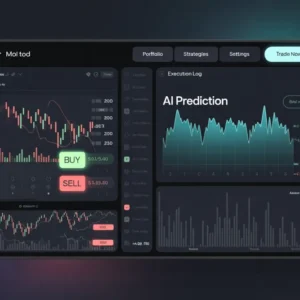AI Ethics Guidelines: Key Takeaways
- AI ethics guidelines are evolving rapidly, with 2025 bringing stronger focus on algorithmic transparency and human-centered design principles
- Organizations implementing responsible AI frameworks see 35% fewer ethical incidents and 27% better public trust ratings
- Bias prevention requires both diverse development teams and ongoing algorithmic auditing – most successful companies now conduct quarterly assessment
- Privacy protection is becoming central to AI ethics, with data minimization emerging as a core principle alongside informed consent
- Multi-stakeholder input in AI governance creates more robust ethical frameworks that balance innovation with human rights
- The most effective ethics implementations combine clear principles with practical assessment tools and regular training
- Companies failing to adopt ethical AI practices face increasing regulatory penalties (up to 6% of global revenue under EU AI Act) and consumer backlash
Introduction
The AI revolution is accelerating faster than anyone predicted, but its rapid advancement brings profound questions about responsible development and deployment. As AI systems increasingly make decisions that impact human lives, careers, and opportunities, establishing clear ethical guardrails has never been more crucial. This isn’t just philosophical debate – it’s about creating AI that genuinely benefits humanity while minimizing potential harms.
I’ve watched this field evolve dramatically over the past decade, and 2025 stands as a pivotal year when many theoretical frameworks are finally crystallizing into actionable governance systems. Organizations worldwide are recognizing that ethical AI isn’t merely about compliance or public relations – it directly impacts business outcomes, user trust, and society’s willingness to embrace these powerful technologies.
This guide explores the most essential AI ethics guidelines shaping 2025, breaking down complex concepts into practical approaches that organizations can implement today. Whether you’re a developer, business leader, or policy advocate, understanding these principles will help you navigate AI’s future responsibly.
The Evolution of AI Ethics Guidelines
The journey toward comprehensive AI ethics hasn’t been straightforward. Early guidelines focused primarily on preventing obvious harms, but modern frameworks now address subtler issues like representational fairness, environmental impact, and long-term societal consequences.
Initially, ethics guidelines emerged from individual organizations like Google and Microsoft, reflecting their specific concerns and values. By 2020, we saw international bodies like UNESCO and the European Commission developing broader frameworks aimed at creating cross-border standards. Today’s landscape features a rich ecosystem of guidelines from governments, academic institutions, industry consortiums, and civil society organizations.
Major Influences Shaping 2025 Guidelines
Several key developments are significantly influencing AI ethics as we approach 2025:
The EU AI Act represents the world’s first comprehensive legal framework specifically addressing artificial intelligence risks and requirements. Its risk-based approach has become influential far beyond Europe’s borders, with many global organizations adopting similar classification systems for their AI applications. The Act’s emphasis on transparency, documentation, and human oversight has become a de facto standard for responsible development.
Meanwhile, UNESCO’s Recommendation on the Ethics of AI has proven particularly influential in promoting inclusive, globally relevant ethical frameworks. Its emphasis on cultural diversity and accessibility has helped address critiques that earlier guidelines reflected primarily Western perspectives. As UNESCO explains in their comprehensive ethics recommendation, ensuring AI benefits diverse populations requires incorporating multiple worldviews.
Corporate accountability has also evolved substantially. Leading tech companies have established independent ethics boards with actual decision-making authority, moving beyond the “ethics-washing” criticized in earlier years. Google’s AI Principles exemplify this evolution, providing both aspirational goals and specific prohibited applications.
From Guidelines to Governance
The most significant shift in 2025’s approach to AI ethics is the movement from voluntary guidelines to robust governance structures. Organizations are implementing concrete mechanisms to translate ethical principles into operational reality:
- Ethics review boards with diverse membership and clear authority
- Mandatory impact assessments before deploying high-risk AI systems
- Continuous monitoring systems that detect emerging ethical issues
- Transparent reporting of ethical metrics alongside performance metrics
- Incentive structures that reward ethical considerations in development
This evolution reflects growing recognition that ethical AI requires systematic governance rather than occasional consideration. As organizations integrate AI tools for business operations, embedding ethics throughout the development lifecycle becomes essential.
Core Ethical Principles for 2025
While frameworks vary in emphasis and terminology, several fundamental principles have emerged as essential components of responsible AI development.
Transparency and Explainability
In 2025’s landscape, “black box” AI systems face increasing scrutiny. Users, regulators, and affected individuals increasingly demand meaningful explanations of how AI systems reach their decisions. This principle extends beyond technical documentation to include accessible explanations for non-technical stakeholders.
The European Commission’s Ethics Guidelines for Trustworthy AI emphasize this need for multi-level explainability, where different stakeholders receive appropriately tailored explanations. Technical teams need comprehensive information about model architecture and training data, while end-users require clear, non-technical explanations of factors influencing their specific outcomes.
Practical implementation includes:
- Developing inherently interpretable models when possible
- Creating explanation interfaces that highlight key decision factors
- Documenting data sources, model limitations, and confidence levels
- Enabling meaningful human oversight of automated decisions
Organizations that excel in transparency often use visualization tools and layered explanation systems that provide appropriate detail based on user needs. This approach builds trust while supporting informed decision-making.
Fairness and Non-discrimination
Preventing bias and discrimination remains central to AI ethics in 2025. This principle recognizes that AI systems can perpetuate or amplify historical inequities if not carefully designed and monitored.
Effective bias prevention requires examination throughout the AI lifecycle:
- Representative and balanced training data
- Diverse development teams with varied perspectives
- Regular testing for disparate impacts across demographic groups
- Remediation processes when biases are identified
“Fairness isn’t one-size-fits-all,” explains Maya Chen, AI ethics researcher. “Different contexts may require different fairness definitions, whether that’s demographic parity, equal opportunity, or individual fairness.” Organizations must explicitly define their fairness criteria for each application.
The most advanced organizations conduct regular algorithmic audits using standardized metrics while recognizing that quantitative measures alone aren’t sufficient. They complement metrics with qualitative assessment from diverse stakeholders, particularly those from potentially affected communities.
Human Agency and Oversight
As AI capabilities expand, preserving meaningful human control becomes increasingly important. In 2025, guidelines emphasize that AI should augment human capabilities rather than replace human judgment, particularly in high-stakes domains.
The U.S. Department of Defense AI ethics principles highlight this need for appropriate human judgment, ensuring that humans maintain “the power to decide when and how to deploy AI systems.” This principle recognizes that algorithmic recommendations should inform rather than dictate human decisions.
Practical implementations include:
- Clear delineation of AI and human responsibilities
- Meaningful human review of high-stakes automated decisions
- Override mechanisms that allow intervention when necessary
- Training that helps humans effectively collaborate with AI systems
Organizations implementing strong human oversight typically design AI as a decision support tool rather than an autonomous decision-maker. They clearly communicate to both operators and affected individuals which aspects of processes remain under human control.
Privacy and Data Governance
In 2025, responsible data practices form the foundation of ethical AI. This principle extends beyond basic legal compliance to include thoughtful consideration of data collection, storage, and usage throughout AI systems’ lifecycles.
Privacy-preserving techniques have evolved significantly, with organizations increasingly adopting:
- Federated learning that keeps personal data on user devices
- Differential privacy to analyze data while protecting individual information
- Data minimization principles that limit collection to essential information
- Clear consent mechanisms that provide genuine user choice
As noted in Transcend’s comprehensive analysis of AI ethics, “Privacy shouldn’t be an afterthought but must be designed into AI systems from the beginning.” This privacy-by-design approach integrates data protection throughout development rather than adding it later.
Organizations with mature privacy practices incorporate regular data protection impact assessments before developing new AI applications. They establish clear data governance policies that specify retention periods, access controls, and accountability mechanisms.
Implementing Ethical AI Frameworks
Transforming ethical principles into organizational practice requires systematic approaches and concrete tools.
Assessment and Audit Tools
Practical implementation begins with structured assessment methodologies. Leading organizations have developed specialized tools to evaluate ethical considerations throughout the AI lifecycle:
- Pre-development impact assessments that identify potential risks
- Algorithmic fairness testing tools that detect demographic disparities
- Documentation templates that capture key ethical decision points
- Monitoring systems that track ethical metrics in deployed systems
IBM’s AI Fairness 360 toolkit exemplifies these emerging resources, providing open-source algorithms to detect and mitigate bias. Similar tools are now available for explainability, privacy assessment, and robustness testing, creating a comprehensive ecosystem for ethical evaluation.
Organizations successfully implementing these tools typically integrate them into existing development workflows rather than treating ethics as a separate “compliance check.” This integration helps developers identify and address issues early, when modifications are most feasible.
Training and Culture Development
Technical tools alone aren’t sufficient – creating ethical AI requires developing organizational culture and individual capabilities. Effective training programs go beyond abstract principles to provide practical guidance for specific roles:
- Developers learn techniques for bias detection and mitigation
- Product managers incorporate ethics into requirements and prioritization
- Data scientists understand privacy-preserving analytics methods
- Leadership teams consider ethical implications in strategic planning
At TechMim, we’ve observed that organizations with successful ethics implementations typically combine formal training with informal knowledge-sharing mechanisms. They create spaces for ongoing discussion, recognize team members who identify ethical issues, and share case studies of successful ethical problem-solving.
The UN System’s principles for ethical AI use emphasize this culture-building approach, noting that “promoting a culture of responsible innovation” requires both formal policies and supportive environments for ethical deliberation.
Ethical AI in Practice: Case Studies
Abstract principles become clearer through concrete examples. These case studies demonstrate how organizations have successfully implemented ethical AI frameworks.
Healthcare AI: Balancing Accuracy and Inclusion
When developing a diagnostic support system, a healthcare technology company discovered their algorithm performed inconsistently across demographic groups. Rather than proceeding with a “good enough” model, they:
- Expanded their dataset to include underrepresented populations
- Created separate performance metrics for specific demographic groups
- Involved medical professionals from diverse backgrounds in validation
- Implemented a confidence scoring system that flagged uncertain predictions for human review
The result was a system that maintained high overall accuracy while significantly reducing performance disparities. Their transparent documentation of these efforts strengthened provider trust and regulatory acceptance.
This case demonstrates how combining technical approaches (expanded data, confidence metrics) with inclusive processes (diverse validation) creates more equitable AI systems. Their experience also highlights that addressing ethical concerns often improves overall system performance rather than compromising it.
Financial Services: Explaining Complex Decisions
A financial services firm implementing an AI-powered loan approval system recognized the need for meaningful explainability. They developed a multi-layered approach:
- For regulators: Comprehensive documentation of model architecture, training data characteristics, and fairness metrics
- For loan officers: Interactive dashboards showing key factors influencing specific decisions and allowing “what-if” analysis
- For applicants: Clear, jargon-free explanations of major factors affecting their outcomes and actionable steps for improvement
This approach satisfied regulatory requirements while providing practical value to both employees and customers. The explainability system actually increased application approvals by helping borderline applicants understand how to improve their profiles.
When implementing AI copywriting software or other customer-facing tools, similar transparency principles help build trust and improve outcomes. At TechMim, we’ve found that explaining how AI generates content creates more confident usage and better results.
Looking Ahead: The Future of AI Ethics
The AI ethics landscape continues evolving rapidly. Several emerging trends will likely shape guidelines beyond 2025:
Collective governance models are gaining traction, with industry-specific consortiums developing shared standards and accountability mechanisms. These collaborative approaches recognize that ethical AI often requires coordination across organizational boundaries.
Environmental impact considerations are expanding ethical frameworks to include AI’s carbon footprint and resource consumption. Sustainable AI development is becoming a distinct ethical principle alongside traditional concerns.
Global harmonization efforts seek to reconcile different regional approaches while respecting cultural variation. Organizations like the Global Partnership on AI are working to identify common principles that can function across jurisdictions while allowing appropriate local adaptation.
Rights-based frameworks are increasingly influential, grounding AI ethics in established human rights principles rather than creating entirely new ethical systems. This approach connects AI governance to well-established legal and moral traditions.
As these trends develop, organizations that establish strong ethical foundations today will be better positioned to adapt to tomorrow’s requirements. Building ethics into organizational DNA creates resilience in a rapidly changing landscape.
Conclusion
Implementing robust AI ethics guidelines isn’t just about avoiding harm—it’s about creating better, more trusted, and more valuable AI systems. The organizations leading in 2025 recognize that ethics and innovation strengthen rather than oppose each other.
The path forward requires both technical solutions and human wisdom. It demands diverse perspectives, ongoing vigilance, and willingness to reconsider approaches when necessary. But the reward is significant: AI systems that genuinely serve human flourishing while minimizing potential harms.
Whether you’re just beginning your AI journey or refining existing ethical frameworks, remember that this work is inherently collaborative. Share your experiences, learn from others’ challenges, and contribute to the evolving conversation. Together, we can ensure AI’s tremendous potential serves humanity’s highest aspirations.
Need help integrating ethical AI into your business practices? TechMim offers free web solution consultations to help you leverage responsible AI tools while maintaining strong ethical standards. Let’s build the future of technology together—one that’s innovative, inclusive, and aligned with human values.
Frequently Asked Questions
What makes 2025’s AI ethics guidelines different from earlier versions?
2025 guidelines emphasize practical governance mechanisms over abstract principles, integrate perspectives from diverse global stakeholders, and include implementation tools alongside aspirational values. They also reflect lessons from early implementation attempts.
How can small businesses implement AI ethics without dedicated resources?
Start with pre-deployment risk assessment, use open-source evaluation tools, document key decisions, seek diverse feedback on AI outputs, and join industry groups sharing ethics resources. Even simple processes significantly improve ethical outcomes.
Which industries face the strictest AI ethics requirements in 2025?
Healthcare, financial services, criminal justice, and education face the most stringent requirements due to potential human impact. Critical infrastructure and public services also face heightened scrutiny and regulation.
How do AI ethics guidelines address rapidly evolving capabilities like generative AI?
Modern guidelines emphasize adaptable frameworks over technology-specific rules. They focus on risk assessment processes, transparency requirements, and human oversight that can evolve alongside technical capabilities.
What penalties might organizations face for violating ethical AI principles?
Consequences include regulatory fines (up to 6% of global revenue under the EU AI Act), legal liability for resulting harms, reputational damage affecting customer trust, and potential requirements to withdraw AI systems from market.
How can organizations balance innovation speed with ethical considerations?
Integrate ethics into early development phases rather than treating it as final approval. Create clear assessment processes, train teams on common issues, and develop reusable components that already incorporate ethical considerations.
Are global AI ethics standards becoming more unified or more fragmented?
Both trends exist simultaneously—core principles are converging globally while implementation approaches remain diverse. Organizations increasingly adopt baseline global standards while adapting specific practices to regional requirements.















